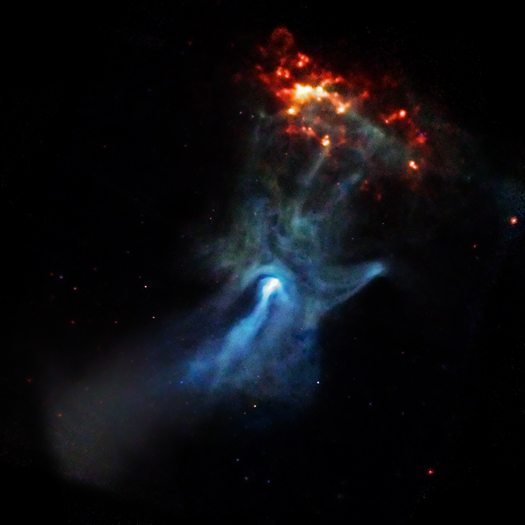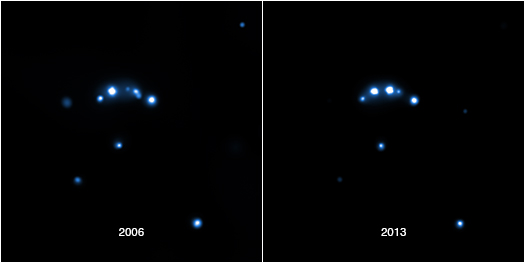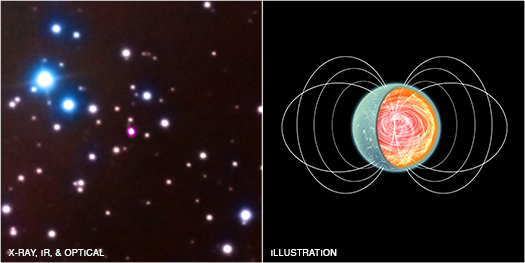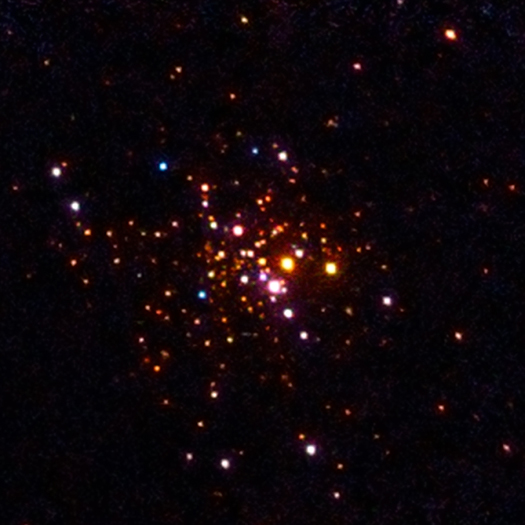Submitted by chandra on Sun, 2014-02-16 18:38
Lucia Pavan graduated with a master thesis in astronomy at the University of Padova (the same town from which Galileo discovered Jupiter's moons). Four years later she also got her PhD in Physics at the same university, working on "magnetars" -a particular kind of pulsars, with the highest magnetic fields. After the PhD, she obtained a postdoc position at the University of Geneva - Switzerland, working at the INTEGRAL Science Data Center (ISDC). In between, she moved to the US, working at University of Wisconsin-Madison for a few months. She currently lives in Geneva, working at the ISDC.
When I started to work on the sources discovered by the INTEGRAL satellite, I didn’t expect to find an object that was extraordinary not only for the properties of its emission, but also for its extension and shape in the sky. And yet this was the case when I came across IGR J11014-6103.
INTEGRAL is an ESA satellite in operation since 2002, sensitive mainly to X-ray and gamma-ray bands. The satellite has been accumulating data since the beginning of the mission, providing information on an always-growing number of X-ray emitters. It is thanks to this ability that new objects are continuously discovered. A large fraction of the sources that INTEGRAL has found still lacks any physical classification, a perfect area for new findings to be done.
Submitted by chandra on Wed, 2013-12-11 16:30

When we released Chandra’s image of the pulsar known as PSR B1509-58 (or, B1509, for short), it received a lot of attention. It's a fascinating object. The pulsar at the center of the image is a rapidly spinning dense star that is spewing out energetic particles into beautiful structures spanning trillions of miles that glow in X-ray light. And, it looks like a giant hand. This fact helped trigger a whole host of other comments about this object found some 17,000 light years from Earth.
Submitted by chandra on Tue, 2013-12-03 16:50
We'd like to welcome guest blogger Sebastian Heinz, Associate Professor in the Astronomy Department at the University of Wisconsin-Madison. He received his Ph.D. at the University of Colorado at Boulder. He studies relativistic jets -- a phenomenon observed around black holes and neutron stars, and began work on the project described here when he was a Chandra Postdoctoral Fellow at MIT.
Circinus X-1 had been a puzzle to X-ray astronomers almost from the moment of its discovery. It is an X-ray binary -- a neutron star sucking matter away from a companion star it is in orbit with, and it shines brightly when that matter spirals inward and eventually lands on the neutron star's surface. But it had defied classification into the basic categories scientists have been using for X-ray binaries. In some ways it behaves like a very young source, like the fact that the orbit of the two stars seems to change rapidly (and whenever things change rapidly in astronomy, we tend to infer that they cannot be very old). In other ways, it behaves like an old neutron star -- one that has lost most of the intense magnetic field which neutron stars are believed to be born with. It also blasts powerful streams of hot plasma, called jets, into interstellar space. And that's why I became interested. I study jets and I wanted to know why the jets from Circinus X-1 were able to light up and stay lit on scales of a few light years when other microquasar jets flared and then dimmed.
Submitted by chandra on Thu, 2013-09-26 10:58

These two images from NASA's Chandra X-ray Observatory show a large change in X-ray brightness of a rapidly rotating neutron star, or pulsar, between 2006 and 2013. The neutron star - the extremely dense remnant left behind by a supernova - is in a tight orbit around a low mass star. This binary star system, IGR J18245-2452 (mouse over the image for its location) is a member of the globular cluster M28.
Submitted by chandra on Wed, 2013-05-22 23:57

This graphic shows an exotic object in our galaxy called SGR 0418+5729 (SGR 0418 for short). As described in our press release, SGR 0418 is a magnetar, a type of neutron star that has a relatively slow spin rate and generates occasional large blasts of X-rays.
The only plausible source for the energy emitted in these outbursts is the magnetic energy stored in the star. Most magnetars have extremely high magnetic fields on their surface that are ten to a thousand times stronger than for the average neutron star. New data shows that SGR 0418 doesn't fit that pattern. It has a surface magnetic field similar to that of mainstream neutron stars.
Submitted by chandra on Thu, 2013-03-28 10:20
Note: An earlier version of this article appeared on this blog by Peter Edmonds.
The collapse of a massive star in a supernova explosion is an epic event. In less than a second a neutron star (or in some cases a black hole) is formed and the implosion is reversed, releasing prodigious amounts of light that can outshine billions of Suns. That is a spectacular way to be born. Here, I'll explain that the properties of neutron stars are no less spectacular, even though they are not as famous as their collapsed cousins, black holes.
Because of the incredible pressures involved in core collapse, the density of neutron stars is astounding: all of humanity could be squashed down to a sugar cube-sized piece of neutron star. The escape velocity from their surface is over half the speed of light but an approaching rocket ship would be stretched, then crushed and assimilated into the surface of the star in a moment. Resistance would be futile.
Submitted by chandra on Wed, 2013-03-06 09:18

Neutron stars, the ultra-dense cores left behind after massive stars collapse, contain the densest matter known in the Universe outside of a black hole . New results from Chandra and other X-ray telescopes have provided one of the most reliable determinations yet of the relation between the radius of a neutron star and its mass. These results constrain how nuclear matter - protons and neutrons, and their constituent quarks, interact under the extreme conditions found in neutron stars.
Submitted by chandra on Mon, 2013-01-07 11:33
It's a pleasure to welcome Martin Durant, of the University of Toronto, for a guest blog article giving more background about his work on the striking variations discovered in the Vela Pulsar.
Pulsars, the remnants of exploded massive stars, are fascinating objects. They have more mass than the sun, squeezed into a ball the size of a city, making them denser than the nucleus of an atom. Add to this mixture immense magnetic fields and rapid rotation, and you have the perfect mix of high energy particles and fundamental forces – nuclear, electromagnetic and gravitational – to put the extreme limits of physical models to the test. Each pulsar, when studied in sufficient detail, appears to be unique. To understand the differences between these exotic objects, we must use all available information and collect data across the spectrum, from radio to gamma rays.
Pages